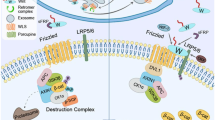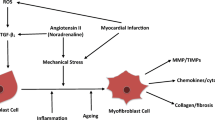Abstract
The primary culture of neonatal mice cardiomyocyte model enables researchers to study and understand the morphological, biochemical, and electrophysiological characteristics of the heart, besides being a valuable tool for pharmacological and toxicological studies. Because cardiomyocytes do not proliferate after birth, primary myocardial culture is recalcitrant. The present study describes an improved method for rapid isolation of cardiomyocytes from neonatal mice, as well as the maintenance and propagation of such cultures for the long term. Immunocytochemical and gene expression data also confirmed the presence of several cardiac markers in the beating cells during the long-term culture condition used in this protocol. The whole culture process can be effectively shortened by reducing the enzyme digestion period and the cardiomyocyte enrichment step.



Similar content being viewed by others
References
Ahuja, P.; Sdek, P.; MacLellan, W.R. Cardiac myocyte cell cycle control in development, disease, and regeneration. Physiol. Rev. 87(2):521–544; 2007.
Bahi, N.; Zhang, J.; Llovera, M.; Ballester, M.; Comella, J.X.; Sanchis, D. Switch from caspase-dependent to caspase-independent death during heart development: essential role of endonuclease G in ischemia-induced DNA processing of differentiated cardiomyocytes. J. Biol. Chem. 281(32):22943–22952; 2006.
Bick, R.J.; Snuggs, M.B.; Poindexter, B.J.; Buja, L.M.; Van Winkle, W.B. Physical, contractile and calcium handling properties of neonatal cardiac myocytes cultured on different matrices. Cell Adhes. Commun. 6(4)301–310; 1998.
Blondel, B.; Roijen, I.; Cheneval, J.P. Heart cells in culture: a simple method for increasing the proportion of myoblasts. Experientia 27:356–358; 1971.
Bryja, V.; Bonilla, S.; Cajánek, L.; Parish, C.L.; Schwartz, C.M.; Luo, Y.; et al. An efficient method for the derivation of mouse embryonic stem cells. Stem. Cells 24(4)844–849; 2006.
Chlopclkova, Š.; Psotova, J.; Miketova, P. Neonatal rat cardiomyocytes—a model for the study of morphological, biochemical and electrophysiological characteristic of the heart. Biomed. Papers 145:49–55; 2001.
Chomczynski, P.; Sacchi, N. Single-step method of RNA isolation by acid guanidinium thiocyanate–phenol–chloroform extraction. Anal. Biochem. 162(1):156–159; 1987.
Clark, W.J. Selective control of fibroblast proliferation and its effect on cardiac muscle differentiation in vitro. Dev. Biol. 52:263–282; 1976.
Desmond, W.J.; Harary I. In vitro studies of beating heart cells in culture. XV. Myosin turnover and the effect of serum. Arch. Biochem. Biophys. 151:285–294; 1972.
Duarte, A.I.; Proença, T.; Oliveira, C.R.; Santos, M.S.; Rego C. Insulin restores metabolic function in cultured cortical neurons subjected to oxidative stress. Diabetes 55:2863–2870; 2006.
Fioramonti, M.C.; Bryant, J.C.; Mcquilkin, W.T.; Evans, V.J.; Sanford, K.K.; Earle, W.R. The effect of horse serum residue and chemically defined supplements on proliferation of Strain L Clone 929 Cells from the Mouse. Cancer Res. 15(11):763–766; 1955.
Flanders, K.C.; Holder, M.G.; Winokur, T.S. Autoinduction of mRNA and protein expression for transforming growth factor-βs in cultured cardiac cells. J. Mol. Cell Cardiol. 27(2):805–812; 1995.
Fu, J.; Gao, J.; Pi, R.; Liu, P. An optimized protocol for culture of cardiomyocyte from neonatal rat. Cytotechnology 49:109–116; 2005.
Haas, R.; Banerji, S.S.; Culp, L.A. Adhesion site composition of murine fibroblasts cultured on gelatin-coated substrata. J. Cell Physiol. 120(2):117–125; 1984.
Harary, I.; Farley, B. In vitro studies on single beating rat heart cells II intercellular communication. Exp. Cell Res. 29:466–474; 1963.
Healy, G.M.; Parker, R.C. Cultivation of mammalian cells in defined media with protein and nonprotein supplements. J. Cell Biol. 30(3):539–553; 1966.
Kruppenbacher, J.P.; May, T.; Eggers, H.J.; Piper, H.M. Cardiomyocytes of adult mice in long-term culture. Naturwissenschaften 80:132–134; 1993.
Limaye, D.A.; Shaikh, Z.A. Cytotoxicity of cadmium and characteristics of its transport in cardiomyocytes. Toxicol. Appl. Pharmacol. 154(1):59–66; 1999.
Mark, G.E.; Strasser, F.F. Pacemaker activity and mitosis in cultures of newborn rat heart ventricle cells. Exp. Cell Res. 44:217–233; 1966.
Matsuura, K.; Wada, H.; Nagai, T.; Iijima, Y.; Minamino, T.; Sano, M.; et al. Cardiomyocytes fuse with surrounding noncardiomyocytes and reenter the cell cycle. J. Cell Biol. 167(2):351–363; 2004.
McKoy, G.; Bicknell, K.A.; Patel, K.; Brooks, G. Developmental expression of myostatin in cardiomyocytes and its effect on foetal and neonatal rat cardiomyocyte proliferation. Cardiovasc. Res. 74(2):304–312; 2007.
Nickson, P.; Toth, A.; Erhardt, P. PUMA is critical for neonatal cardiomyocyte apoptosis induced by endoplasmic reticulum stress. Cardiovasc. Res. 73(1):48–56; 2007.
Nuss, H.B.; Marban, E. Electrophysiological properties of neonatal mouse cardiac myocytes in primary culture. J. Physiol. 479(2):265–279; 1994.
Pellieux, C.; Foletti, A.; Peduto, G.; Aubert, J. F.; Nussberger, J.; Beermann, F.; et al. Dilated cardiomyopathy and impaired cardiac hypertrophic response to angiotensin II in mice lacking FGF-2. J. Clin. Invest. 108:1843–1851; 2001.
Polinger, I.S. Separation of cell types in embryonic heart cell cultures. Exp. Cell Res. 63:78–82; 1970.
Rao, V.; Merante, F.; Weisel, R.D.; Shirai, T.; Ikonomidis, J.S.; Cohen, G.; et al. Insulin stimulates pyruvate dehydrogenase and protects human ventricular cardiomyocytes from simulated ischemia. J. Thorac. Cardiovasc. Surg. 116(3):485–494; 1998.
Remião, F.; Carmo, H.; Carvalho, F.; Bastos, M.L. Cardiotoxicity studies using freshly isolated calcium-tolerant cardiomyocytes from adult rat. In Vitro Cell Dev. Biol.—Animal 37:1–4; 2001.
Rosenblatt, V.N.; Lepore, M.G.; Cartoni, C.; Beermann, F.; Pedrazzini, T. FGF-2 controls the differentiation of resident cardiac precursors into functional cardiomyocytes. J. Clin. Invest. 115(7):1724–1733; 2005.
Shields, P.P.; Dixon, J.E.; Glembotski, C.C. The secretion of atrial natriuretic factor-(99–126) by cultured cardiac myocytes is regulated by glucocorticoids. J. Biol. Chem. 26:3126–3128; 1988.
Simpson, P.; Savion, S. Differentiation of myocytes in single cell cultures with and without proliferating nonmyocardial cells. Circ. Res. 50:101–116; 1982. Circ. Res. 50:101–116; 1982.
Song, W.; Lu, X.; Feng, Q. Tumor necrosis factor-alpha induces apoptosis via inducible nitric oxide synthase in neonatal mouse cardiomyocytes. Cardiovasc. Res. 45(3):595–602; 2000.
Wang, G.W.; Kang, Y.J. Inhibition of doxorubicin toxicity in cultured neonatal mouse cardiomyocytes with elevated metallothionein levels. J. Pharmacol. Exp. Ther. 288(3):938–944; 1999.
Yamashita, N.; Nishida, M.; Hoshida, S.; Kuzuya, T.; Hori, M.; Taniguchi N.; et al. Induction of manganese superoxide dismutase in rat cardiac myocytes increases tolerance to hypoxia 24 h after preconditioning. J. Clin. Invest. 94:2193–2199; 1994.
Acknowledgments
This work is supported by grants to R.S.V. by the Ministry of Human Resource Development (MHRD—BIO/2005–2006/007/MHRD/RAMS/859) and Department of Biotechnology, Ministry of Science and Technology (DBT-BT/PR5392/MED/14/693/2004).
Author information
Authors and Affiliations
Corresponding author
Additional information
Editor: J. Denry Sato.
Electronic supplementary material
Below is the link to the electronic supplementary material.
Cardiomyocte beating in cluster (MPG 1.15 MB)
Individual beating cardiomyocytes (MPG 988 kb)
Single beating cardiomyocyte (MPG 982 kb)
(MPG 1.42 MB)
Supplementary Table 1
PCR primers used for the study (DOC 30.5 KB)
Rights and permissions
About this article
Cite this article
Sreejit, P., Kumar, S. & Verma, R.S. An improved protocol for primary culture of cardiomyocyte from neonatal mice. In Vitro Cell.Dev.Biol.-Animal 44, 45–50 (2008). https://doi.org/10.1007/s11626-007-9079-4
Received:
Accepted:
Published:
Issue Date:
DOI: https://doi.org/10.1007/s11626-007-9079-4




